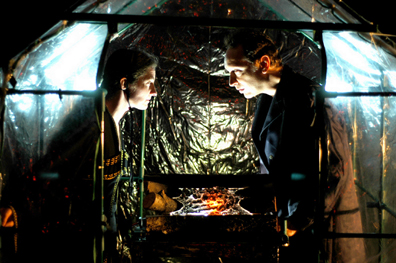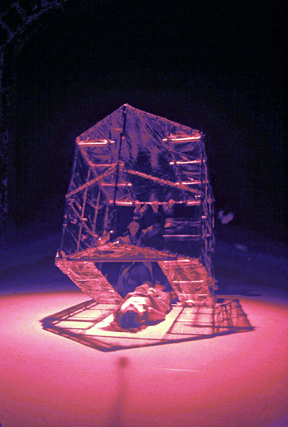Mysterious, Imaginative Plan B
Plan B
Big Dance Theater
Dance Theater Workshop
September 23, 2004
By
Susan Reiter
copyright
© 2004 by Susan Reiter
published October 4, 2004
 It
can be a tricky business, incorporating and intertwining elements from
disparate, unrelated sources into a multi-layered performance piece. Sometimes
the logic and vision behind the blend, however well thought through by
the creative team, don't resonate fully with the viewer. But sometimes
things mysteriously, inexplicably but persuasively come together and one
is invited into a unique imaginary world.
It
can be a tricky business, incorporating and intertwining elements from
disparate, unrelated sources into a multi-layered performance piece. Sometimes
the logic and vision behind the blend, however well thought through by
the creative team, don't resonate fully with the viewer. But sometimes
things mysteriously, inexplicably but persuasively come together and one
is invited into a unique imaginary world.
Dance Theater Workshop seems to be favoring this kind of mixed-source dance-theater work, having opened its season with "Our Little Sunbeam," in which 33 Fainting Spells combined Chekhov with astronauts' journals. That work's mélange of material never cohered into something greater than the some of its parts. But "Plan B," the latest offering from the ever-intriguing Big Dance Theater, subtly and stealthily creates its own magic as it weaves together an unlikely assemblage of source material into a resonant work that is part parable, part political intrigue, and part dreamscape.
The cast is small—three women, one man—but the components, and influences, are substantial. The seamless direction and choreography by BDT co-directors Annie-B Parson and Paul Lazar are paramount to the work's potency, but the deft set design and costumes, whimsical and precise props, old-but-new music by Gary Lucas, as well as subtle lighting and sound design all make important contributions. The script—a collaboration between playwright Len Jenkin, Mr. Lazar, and Molly Hickok—is a major component of the piece, but it has been honed and artfully incorporated into the larger mix.
The primary sources behind "Plan B" (which is being performed through October 9th) were the "secret" tape recordings from the Nixon presidency and the diaries of Kaspar Hauser, the famous 19th-century German "wild child" who spent his childhood and adolescence living far from civilization before emerging to confront it at age sixteen. These elements, and other sources, are translated and incorporated, into the finished work, so that you can relate the characters in the performance to their real-life counterparts, even as they take you along on their own distinctive journeys.
Tymberly Canale, a wonderfully focused performer with a sweetly open and trusting face, is the central figure—a female version of Hauser, an uncorrupted innocent whom others train and manipulate. The Nixonian connection is made clear in Mr. Lazar's deliciously entertaining portrayal of a tense, shifty, bible-quoting operator who barks orders to—and relies intensely on—a briskly efficient, morally conflicted assistant he calls "Rose." His language pours out in a convoluted stream that incorporates football metaphors and inept misuses of elaborate words such as "bouillabaisse." He's both demonic and endearing, intent on carrying out, with Rose's cooperation, a seemingly crucial plan of action that has no evident purpose. Ms. Hickok, a wonderfully versatile Big Dance Theater veteran, suggests mysterious undertones behind Rose, and makes her clearly much more knowing than her possibly deluded boss, yet unwilling (or unable) to refuse his commands.
The opening minutes have a scattershot quality (what is heard and seen then makes more sense by the end, when some of it is reiterated), as Ms. Canale is presented with various objects and items of clothing by two odd, almost kabuki-like attendants. Childlike and tremulous, she dotes on a small metal toy horse. When a miniature skeletal "house" with transparent walls appears, gliding downstage with tiny white lights adding to its glistening glow, the charm of the moment is quickly dispelled as it is titled forward so that its "doorway" covers the prone Ms. Canale.
 Once
it's again righted, the "house" serves mainly as Mr. Lazar's
base of operations, conveniently outfitted with microphones or telephones
as needed as he juicily delivers his reams of Nixon-inspired delusions.
Gradually, he and "Rose" come to focus on Ms. Canale's unidentified
lost waif as the ideal, unwitting pawn for a vital delivery that must
be performed as part of their master plan. Headphones are clamped on her
unsuspecting ears, as she hears and repeats basic facts of life and questionable
moral instruction. This "educated," she still seems no more
prepared for the cruel, manipulative world in which she finds herself.
Once
it's again righted, the "house" serves mainly as Mr. Lazar's
base of operations, conveniently outfitted with microphones or telephones
as needed as he juicily delivers his reams of Nixon-inspired delusions.
Gradually, he and "Rose" come to focus on Ms. Canale's unidentified
lost waif as the ideal, unwitting pawn for a vital delivery that must
be performed as part of their master plan. Headphones are clamped on her
unsuspecting ears, as she hears and repeats basic facts of life and questionable
moral instruction. This "educated," she still seems no more
prepared for the cruel, manipulative world in which she finds herself.
Scenes shift, as props appear and vanish, with wondrous smoothness and ease. There is a playful, toy-like quality to some of the props and settings—the wilderness is represented by a set piece on wheels featuring a few wisps of branches. The pictorial sense of Big Dance Theater's work is very strong, and the stage picture is always beautifully controlled while open to imaginative possibility. The silver streamers hanging upstage center resemble a gleaming waterfall at the start. Later they part for the dramatic appearance of the transparent house, like the curtains opening on a game show prize. In the closing moments, they part once again as Canale, rising up to defy death, leaves behind the unforgiving world that treated her so harshly, advancing into some unknown beyond, the little toy horse following her.
The fourth performer is Kate Johnson, for many years a luminous Paul Taylor dancer and later a member of White Oak Dance Project, whose role is mysterious but fascinating. Wearing a bonnet and a cascade of flowing hair, she delivers and removes props, and shifts set pieces, with a serene grace and touch of whimsy. She also joins in several dance sequences, moving with grave delicacy. Notable among these pure-movement portions of the piece is a gentle, lyrical dance with fans set to one of Mr. Lucas' "reinterpretations of Taiwanese mid-century movie music" (as the program identifies them). There is a slightly Asian sensibility to the work as a whole, in the way it maintains a reserve and at times places the performers with a ritualistic air. Archival film footage of an early 20th-century Kabuki actor are cited in the program as another element on which the creators drew. Combining all these disparate sources might have been a recipe for disaster in the wrong hands, but Big Dance Theater blends and transforms them with a sureness of vision and an astute sense of both dance and theater, creating a work that tells a quirky, ambiguous tale with resonant strangeness and delicate beauty.
Photos:
First: Molly Hickok and Paul Lazar in "Plan B." Photo
by Mike Van Sleen.
Second: Tymberly Canale in "Plan B." Photo by Cameron
Wittig.
www.danceviewtimes.com
Volume 2, No. 37
October 4, 2004
Copyright
©2004 by Susan Reiter
|
|
|